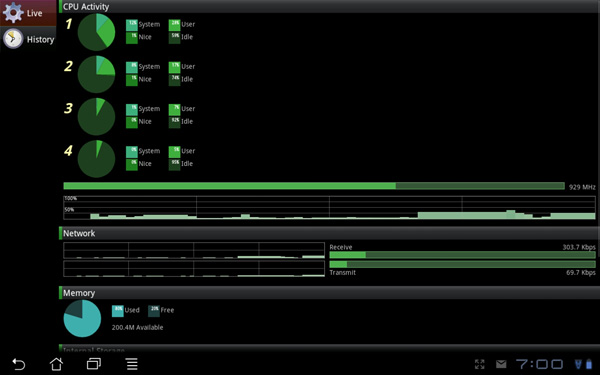I'm not sure it makes sense to say you're completely bottlenecked by the network - the HTTP protocol works as a back-and-forth mechanism where you need to do some amount of parsing (usually small but can be much higher with javascript/AJAX in theory) to determine what you need to ask the webserver to send you next (e.g. images, dynamic content, etc) and then once you've got everything you need after one or more back-and-forths you need to do the final parsing (obviously it's usually possible to display something before that time). I'm also not sure if Android is slightly slower than iOS, but if it is, then that's what SoCs should be judged on though.A 800MHz dual A9 seems to be able to parse 99% of the web pages out there in under a second. While I don't have an iPad 2, I've used them extensively and I honestly cannot think of a time when I was not bottlenecked by the network, even on WiFi.
Still, a few quick tests with my 4S on WiFi do indicate that things load faster than I remembered them to, so you're probably right in practice.
A7 is faster than A8 for web browsing per clock, but clocks significantly lower. The idea is that on 28nm High-K it will be able to clock at more than 1GHz which seems very believable (and more aggressive licensees like Broadcom might get it up to 1GHz on 40nm), but on a comparable process you might get the Cortex-A9 at 1.5GHz or more, so the real performance difference versus the A9 on the same process is at least 2x. I'm also pretty sure that in practice, an A7@1GHz would be slower than an A9@800MHz (although I'm not sure by how much). It's still an extremely good standalone core though, since in many cases two A7s could be cheaper, faster, and lower power than a single A9.Isn't A7 supposed to be fairly quick? Faster than the A8 and scale to around ~1GHz? Two of those would seem sufficient and would pretty much the iPad 2 today, which, as I've pointed out, does not lack in browser performance.
Completely agreed although I'm curious how important that is in practice if you have sufficiently fast power gating. Let's say you have two threads that take 700MHz and 300MHz to complete. Instead of running one core at 1GHz, you could run two cores at 700MHz, and power gate the 2nd core 4/7th of the time. In practice I'm somewhat skeptical OS schedulers will be smart enough to make that work efficiently... And if you need to do that many times a second because it's real-time, you've got quite a bit of power gating overhead (might you still come ahead in terms of power efficiency with clock gating? Hmm, maybe, maybe not)That point has been addressed. Very few consumer level use cases, let alone for mobile, will be able to spread its workload evenly amongst 4 threads.
Disproportionately hot... compared to the volcano? Wow!In a perfect world, I'd also have my own volcano lair and the requisite disproportionately hot lair chick.
And a unicorn.
I'm not sure why you think 4 cores will take less than 2x the power of 2 cores at the same clocks. By definition it should scale linearly - the only thing that's lower power is 4 cores at significantly lower clock speeds (but still >0.5x) than 2 cores and that's exclusively where the power efficiency benefit comes from.sebbbi said:Usually quad core CPUs do not consume twice as much energy as dual cores at same clocks, so we could conclude that the power efficiency is generally slightly better for quad cores (on highly threaded loads).

